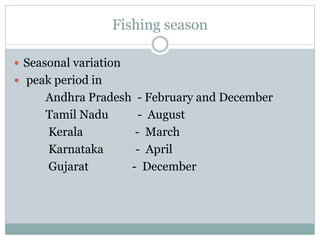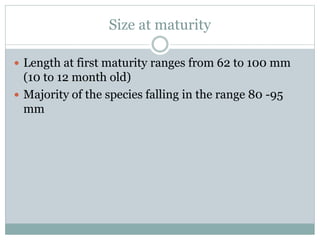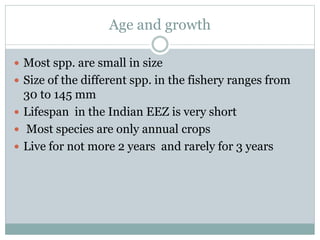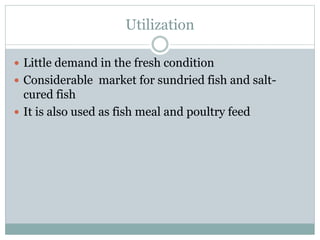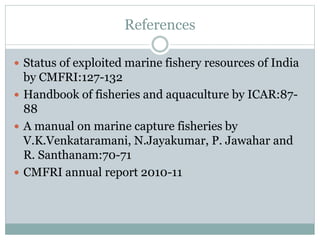Silverbellies
- 1. RESOURCES OF SILVERBELLIES AND THEIR UTILIZATION Jitendra Kumar College of Fisheries Mangalore
- 2. Introduction Belongs to family leiognathidae Commonly called silverbellies, ponyfish and slip mouth About 2.4% of the total marine capture Distributed in the 0-40 m depth range Includes in demersal resources
- 3. Production trends Landing 15,000 t – 1961 49,000 t – 2ooo 68,480 t – 2009 - 2010 Maximum annual landing was about 92,000 t in 1983
- 4. 0 10000 20000 30000 40000 50000 60000 70000 80000 Year 2001 2002 2003 2004 2005 2006 2007 2008 2009 2010 ProductioninTons Years Production trend of silver bellies (2001 – 2010)
- 5. Cont… Tamil Nadu – 70% Kerala – 9.4% Andhra Pradesh – 7.4% Gujarat – 4.4% In southern Tamil Nadu, these fishes are most abundant in the shallow areas of palk bay
- 6. Mode of exploitation Exploited by trawl and variety of artisanal gears like shore seine, boat seine, gill net, etc Trawl net is the major gear as by catch About 80% of landing are contributed by trawl
- 7. Species composition 21 species of silverbellies are known Distribution of species vary from region to region Almost all 21 species are known from southern Tamil Nadu Dominant spp. are Leiognathus dussumieri, L. jonesi, L. splendens, L. brevirostris, L. equulus
- 8. Cont… In the Tamil Nadu and along Andhra Pradesh 12 spp. are known to contribute fishery of which L. bindus, L. spendens and secutor insidiator are most dominant Above three spp. are also known as southern Tamil Nadu but very less abundant in this region In Kerala four spp. such as L. spendens, L. brevirostris, S. insidiator and G. minuta contribute major landing
- 9. Fishing season Seasonal variation peak period in Andhra Pradesh - February and December Tamil Nadu - August Kerala - March Karnataka - April Gujarat - December
- 10. Spawning L. bindus is fractional spawner spawning through out the year in Andhra Pradesh L. dussumieri spawns during April – May in Gulf of Mannar L. spendens spawns through out the year in Kerala Silverbellies are fraction spawners spawning through out the year with one or two peaks of longer duration each year Move to deeper water for spawning Young ones move to the inshore nursery ground
- 11. Size at maturity Length at first maturity ranges from 62 to 100 mm (10 to 12 month old) Majority of the species falling in the range 80 -95 mm
- 12. fecundity L. splendens – 7,000 – 27,000 S. insidiator - 5,000 – 13,000 G. minuta - 12,000 – 27,000
- 13. Age and growth Most spp. are small in size Size of the different spp. in the fishery ranges from 30 to 145 mm Lifespan in the Indian EEZ is very short Most species are only annual crops Live for not more 2 years and rarely for 3 years
- 14. Food and feeding They are mainly zooplankton feeders
- 15. Adaptation 1) The feeding habit of the silverbellies is governed by the their mouth: Secutor spp. and some species of leiognathus has protrusible upward mouth Food is maily plankton Other leiognathus spp. with protrusible downward mouth Feed mainly on benthic organism like the gastropods, polychaetes and crustaceans G. minuta has canine teeth and feed on crustaceans and small fishes
- 16. Cont… 2) Several species of silverbellies spend at part of their life in estuary 3) Species like L. jonesi undertakes diurnal vertical migration less than 60 mm of L. jonesi occupies the column water in day time and descend to bottom in the night Greater than 60 mm remains in the bottom during day time and ascend to the column in the night At bottom they feed on benthos and at column/surface, they feed on plankton
- 17. Cont… 4) Predation on the silverbellies is negligible as compared to pelagic predation on clupeids
- 18. Conservation and management The continuous spawning leads to continuous recruitment As the life span of the silverbellies is short, it is considered that if they are not removed by fishing, they would be subjected to natural death Exploitation of this is not likely to adversely effect the population It is the most important to maintain species diversity and their proportions.
- 19. Utilization Little demand in the fresh condition Considerable market for sundried fish and salt- cured fish It is also used as fish meal and poultry feed
- 20. Conclusion It is the single family marine resource, concentrates at a particular area It is the important to maintain species diversity and their proportions
- 21. References Status of exploited marine fishery resources of India by CMFRI:127-132 Handbook of fisheries and aquaculture by ICAR:87- 88 A manual on marine capture fisheries by V.K.Venkataramani, N.Jayakumar, P. Jawahar and R. Santhanam:70-71 CMFRI annual report 2010-11









